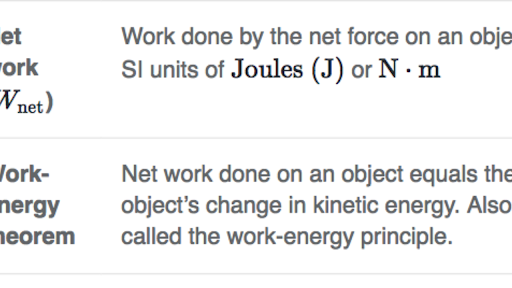Definition Work Kinetic Energy Theorem
The work energy theorem is useful however for solving problems in which the net work is done on a particle by external forces is easily computed and in which we are interested in finding the particles speed at certain positions of even more significance is the work energy theorem as a starting point for a broad generalization of the concept.
Definition work kinetic energy theorem. From the definition of kinetic energy k mv 2 we get the final speed of the box. Force is a vector work and energy are scalars. This definition can be extended to rigid bodies by defining the work of the torque and rotational kinetic energy. The principle of work and kinetic energy also known as the work energy theorem states that the work done by the sum of all forces acting on a particle equals the change in the kinetic energy of the particle.
So we have k f 62 j. The theorem that the change in the kinetic energy of a particle during a displacement is equal to the work done by the resultant force on the particle during this displacement. By the work kinetic energy theorem this is equal to the change in kinetic energy of the box. The work energy theorem can also be applied to an object s potential energy which is known as stored energy when a skier waits at the top of the hill before taking off they have potential.
Work energy theorem the result based on newton s laws that the net work done on an object is equal to its change in kinetic energy kinetic energy the energy an object has by reason of its motion equal to frac 1 2 mv 2 for the translational i e non rotational motion of an object of mass m moving at speed v. Thus it is often easier to solve problems using energy considerations instead of using newton s laws i e. This is the work energy theorem or the relation between kinetic energy and work done. Kinetic energy and the work energy theorem.
Kinetic energy of an object is its capacity to put another object in motion. In other words the work done on an object is the change in its kinetic energy. The kinetic energy ke of an object of mass m that is moving with velocity v is. δk k f k i w net 62 j d here the initial kinetic energy ki was zero because the box was initially at rest.
